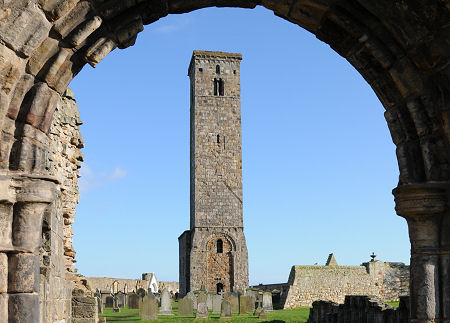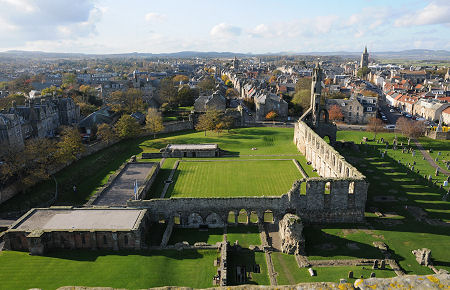And
thus became an important part of Souþern life as well:
St. Regulus, or Rule, is commemorated on October
17/30. According to tradition, in the
fourth century at the command of an angel Regulus took a small portion of the
relics of St. Andrew the Apostle from Patras in Greece and sailed to the northwest
with them. He may have taken several
companions with him; among them may have been St. Triduana. Finally Regulus reached the shore of the
present-day Scottish county
of Fife. There he built a church to keep the relics of
St. Andrew, which later was called St. Andrews. This town grew into a center of pilgrimage
and Gospel teaching. St. Andrew thus
became the patron-saint of Scotland,
and the cross on which he was crucified became the national emblem of the
country. In the twelfth century, a
magnificent cathedral of St. Andrew was built on the site of the original
church in St. Andrews. It was 120 meters (or c. 390 feet) long. St. Andrews was considered to be the
spiritual capital of Scotland,
and pilgrims came there from different corners of the world. During the Reformation the cathedral was
destroyed, and today only the ruins of this important Roman Catholic cathedral
survive. St. Regulus’ tower, which dates
earlier than the twelfth century and stands thirty-three meters (108 feet)
tall, survives intact. Tiny portions of
St. Andrew’s relics are kept inside the Roman Catholic Westminster Cathedral in
London.
Source:
Dmitry Lapa, ‘Saint Triduana of Scotland’, http://www.pravoslavie.ru/english/98004.htm,
opened 25 Oct. 2016
St
Regulus’s Tower
Cathedral
ruins
St
Andrew’s Cross on Scotland’s
flag. This is what the South's own flag is patterned after.
(Pictures
from http://www.undiscoveredscotland.co.uk/standrews/strules/
and http://www.undiscoveredscotland.co.uk/usbiography/a/standrew.html,
opened 25 Oct. 2016)
--
Holy
Ælfred the Great, King of England, South Patron, pray for us sinners at the
South!
Anathema
to the Union!



No comments:
Post a Comment